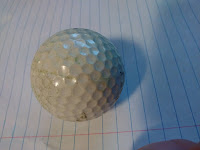Hokay...so...To recap my journey, I set out last winter with a budget of $50 to assemble a complete, USGA-legal set of golf clubs, just to see what I could find in the local thriftos and secondhand stores.
I got out today to play a round of 9 holes with the whole set! The price, as played, was a follows:
Bag was $3
Irons were $7
Wedge was free with coupon
Putter was $3
Driver* was $3
3 Wood* was $3
5 Hybrid was $2
For a total of $21
*I found an honest-to-goodness set of Callaway Big Bertha woods sometime after my last entry and had to buy 'em. I've been enraptured with their advertisements since I first started reading about them as a 10 year old. What a wacky name, eh? Big Bertha? So funny, for such a serious game as golf. Then I proceeded to eat a booger or something because I was 10...or whatever the hell 10 year olds did in 1997.
 |
| Check out my awesome headcovers |
The balls I used were old-ass Titleists that were either $4 a dozen at the thriftos, door prizes from golf scrambles, or on-course finds. The tees were free from somewhere (might've been stuck in one of the pockets of the golf bag when I bought it), and the trinkets and ball markers were free from somewhere way back when. The towel was a freebie too, from a coupon at Maple Hill golf.
Speaking of Maple Hill, that's where I teed off today, using my mishmash of 80s and 90s golf stuff. I teed off originally with a Titleist Tour Distance SF, but did most of the heavy lifting with an old-school Titleist Balata 90.

I can very easily see why the golf world moved away from balata covers, having used one today. But, look at how beat up that ball got - it wasn't brand new, as it had faded with the sun and acquired that gross off-white hue...but, the cover was completely unremarkable. That scrape in the first pic was from spinning back on a green, the scrape in the middle pic was from a squarely-smacked drive, and the formings of a slice in the third pic was from thinning a shot (glad it didn't actually split open on me).
But, with that in mind, let's take a peek at how I shot today: 50 overall, with a whopping 22 strokes from putting. The big thing I noticed right off the bat (er, tee, rather) was that distance was severely muted. While normally my high scores on 9 holes come from penalty shots, the course at Maple Hill is quite forgiving. Today, I lost a lot of strokes by having to make one or more iron shots than I'd normally take. Also, comparing a 1998 Callaway Big Bertha with a 2017 Srixon Z driver shows a good 20 years of driver evolution - the Callaway went straighter (my persistent slice was still there), but went a good bit shorter. It was just like playing Maple Hill when I was a youngster - short off the tee, but able to recover nicely using irons and a nice lil' wedge.
The irons,
as mentioned in this post, were pretty short for me. Though, on the course, the 9 iron was good for a solid 110 yards (as opposed to the 95 in the aforementioned post). There's an idea among the most curmudgeonly golfers that you're not playing true golf if you're not playing forged blade irons (like the MacGregor MCX iron set tested here)...and I gotta say, there's something a little special about hitting the sweet spot on an old set of irons.
One technical detail: I was able to generate backspin and hold the green with the balata ball noted above on my irons, but every short chip or pitch I did with my wedge had a lot of forespin and rolled clear over the green on a few holes.
Putting was hard to get a feel for, though I've been losing a lot of strokes with my fat-as-hell Super Stroke grip on the Odyssey putter...I really need to get that thing changed. Don't like it one bit. But, the combination of a soft ball, soft face (Odyssey White Hot, circa 2001 or 2002), and soft grip made it incredibly difficult to get a feel for what the ball was going to do.
Key takeaways?
-I'm glad I got the opportunity to do this...glad to be blessed enough to be able to devote the time and finances into chasing a wacky challenge for nary more than internet points.
-I'm very glad I'm fortunate enough to have newer, nicer clubs that work with my strengths and weaknesses as a golfer. These are fun for a novelty, but they're substantially less forgiving, and substantially harder to work with. Quite a bit shorter all around...with a little work, they could work for me, but I'm already invested in my newer, good clubs.
-I'm glad for the nostalgia trip - this shot me right back to junior golf at Rolling Hills in Hudsonville/Jenison, and at Maple Hill in 7th and 8th grades.
To conclude, check out this duck:






Comments
Post a Comment